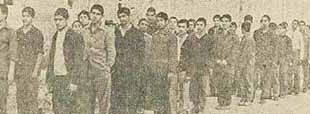The news of Nixon’s trip angered the frustrated population, especially the opposition.The daily Etela’at [information] published the report by the Coroner’s office on December 8, 1953, that reported the cause of death of the three young students:1. Mostafa Bozorgnia, a student at Daneshkadeh Fanni [FOE], died from a bullet that entered [his body] from the right side of [his] chest and exited through his left arm. The bullet crushed the bones in his arm and caused severe bleeding, which killed him. He had also been injured with the tip of a spear that had penetrated his body by 15 cm.
The awarding of the honorary doctorate to Richard Nixon at Tehran University was more than an academic formality; it was a carefully staged political gesture. The Shah of Iran, Mohammad Reza Pahlavi, had returned to power only months earlier after the August 1953 coup, an event in which the United States played a central role. Nixon’s presence in Tehran therefore symbolized American endorsement of the Shah’s restored rule, while the ceremony at the nation’s most prestigious university signaled Iran’s eagerness to align itself with the West.

